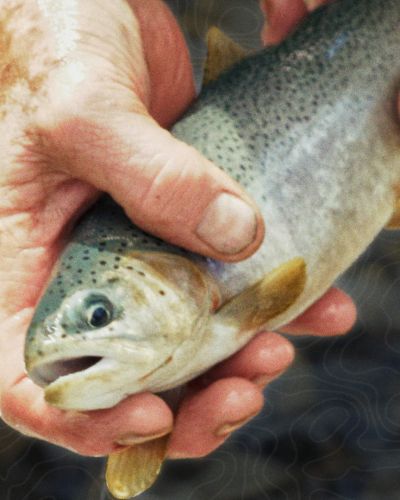The calming tempo of an old clock is all George Piccin needs to begin his craft.
Tick, tick, tick.
Oh, and a 7UP too, while he tediously works at his desk in the basement full of googly eyes, scissors, and a variety of animal hides and feathers.
Piccin is tying his own flies to go fishing in his kayak on a smoky morning deep in the Kootenays of British Columbia.
“I picked it up when I was really young,” Piccin said. “I used to go with my father, my brother, and friends where we’d snare fish and [use] rods. Then I got into fly fishing and then into fly tying.”
As a seasoned expert with over 30 years experience, Piccin has created thousands of ties including wet and dry ties, chironomids (also known as lake flies, they look similar to mosquitoes and are effective for stillwater fly fishing), and more.
His favourite is the duck spratley because it can be used everywhere.
“If there was one fly to use it would be the duck spratley.”
Not only does Piccin do this himself as a way to enhance his fishing experience, but his ties are also made from hair and feathers of animals he’s hunted. Anything from a variety of local birds, to deer, and even badger.
“Whatever animal you can think of,” he said. “If I can’t hunt it then I get it from a trapper so that I can use it.”
He processes the hide, cuts it up into the desired size, and dyes it in different colours. Sometimes Piccin uses different coloured permanent markers instead of dying to ensure he gets the exact colour he is looking for.
“I don’t think it matters to the fish, it’s more to the human being that likes the looks [of it] and draws it to him.”
To tie a fly, Piccin uses a tool called a norvise, which is bolted to his work table and holds the fly while he works on it. He uses crafting supplies such as string, wool, and other tiny tools to perfect his designs.
Some he can create in as little as two minutes, but he said it’s important to take the time to do it right and to critique yourself as you go.
And like something out of a country song, Piccin has a special fly for fishing in the dark.
“I make glow in the dark flies for lingcod… they glow when you hit it with your black light,” he explained. “I put clay on it and then I cook it in the oven – it stinks up the house.”
After it comes out of the oven, he files down the clay tip, dips it in primer, and then it takes a plunge into gold paint. Piccin said once the black light hits the fly it will glow for about an hour.
Piccin said he hopes to get more young people into fly fishing because it’s a good hobby to have and fly tying adds an extra layer of creativity and satisfaction to the sport.
“The joy is that you get to tie it, then go out and catch a fish with it,” he explained. “When you see what you made, you kind of feel good that you made it.”
After working on a few flies during filming, Keelan took his Tacoma out to a local lake with Piccin to see them in action. Piccin unloaded his kayak from the truck and made his way to the water.
The only catch of the day was a small sucker fish, but that didn’t bother him one bit.
“Being in the outdoors and the mountains here in B.C., it’s just relaxing. It’s better than sitting and home and watching TV,” he said. “If I see a fishing show on TV, I shut the TV off and go fishing. If I see a hunting show on TV, I shut the TV off and go hunting. Get out and do the real thing.”
After tying for all these years, Piccin decided to start selling his ties to share his work and make a little extra money to get even more materials for his hobby. So far, he has sold flies in different provinces across Canada such as Ontario, B.C., and Alberta.




1 Comments
George is the GOAT